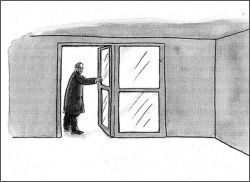 For some time, Dr No has been troubled by a particular aspect of the suicide of Kerrie Wooltorton. It is an aspect that has received little coverage, perhaps because it is a complex and murky area, but it is nonetheless important. It is countertransference, and how it may have influenced Wooltorton’s treatment, even to the extent that it may have contributed to her death.
For some time, Dr No has been troubled by a particular aspect of the suicide of Kerrie Wooltorton. It is an aspect that has received little coverage, perhaps because it is a complex and murky area, but it is nonetheless important. It is countertransference, and how it may have influenced Wooltorton’s treatment, even to the extent that it may have contributed to her death.
Much psychobabble surrounds countertransference, but at its most straightforward, it is the name given to the feelings and emotions generated in a helper by the person being helped. You help a little old lady across the road, she pats your hand and thanks you, and you feel good about yourself: that’s positive countertransference. You cook supper for a depressed friend, and every time you do so he barely touches it, leaving you feeling: you ungrateful sod. That’s negative countertransference.
Countertransference is an everyday fact of life for those who help others for a living. The wise helper keeps an eye on countertransference. Too much positive countertransference can all too easily lead to meddling and over-interference, while negative countertransference, all the more so if it is repressed, as it often is, can result in acting out those negative emotions in ways that are harmful.
Wooltorton was a patient with a long history of difficult problems and diagnoses – a complex gynaecological condition, depression, emotionally unstable personality disorder and numerous suicide attempts.
Such patients are well known to engender negative feelings – a negative countertransference – and antagonistic behaviour – acting out, say by an aggressive execution of a stomach pump – in health care staff. Patients who repeatedly harm themselves, and patients with personality disorders, are especially at risk. Wooltorton, of course, was just such a patient.
Not all negative countertransference need be acted out in obvious ways. It is not seemly for doctors to go about dusting up their patients. But the negative countertransference remains, and if not dealt with – which usually means being aware of it, and managing it – it will fester and emerge in other ways; ways which, although less visible, can be just as if not more sinister than openly expressed aggression.
And so the doctor loaded with repressed negative countertransference may make subtle, and so less obvious, changes to the way he cares for his patient. He may not go the extra mile; he may omit to do what he can and should do. He may, instead of acting out in an openly hostile way, adopt a passive aggressive manner towards his patient.
Now, what troubles Dr No is the extent to which a negative countertransference, acted out through a passive aggressive stance, contributed to Wooltorton’s death. He doesn’t know the answer, but it seems to him a vital question to ask when there is open talk of allowing patients to die, of assisting suicide, and of euthanasia; and where allowing these things would provide a channel for acting out a negative countertransference.
Could it be that the hospital staff experienced what amounts to a mass negative countertransference, and acted it out in a passive aggressive manner? It wouldn’t be difficult to do – and, with a little outside help, it could even be made to look as if they were acting in their patient’s best interests. Passive aggression to perfection.
All that was needed was to cut a few corners; to omit a few steps. No need for a current psychiatric opinion, because we have spoken to the psychiatrist. Presume capacity, because that is what the law says we must do, and back that up with a legal opinion that confirms we must do as the patient tells us, and then – sit back and watch her die.
Like watching a snuff video.
Of course, it could never happen in the real world, where real doctors treat real patients.
